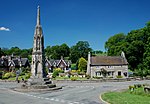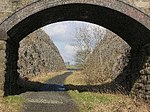Dovedale
Tourist attractions of the Peak DistrictUse British English from March 2022Valleys of DerbyshireValleys of the Peak District

Dovedale is a valley in the Peak District of England. The land is owned by the National Trust and attracts a million visitors annually. The valley was cut by the River Dove and runs for just over 3 miles (5 km) between Milldale in the north and a wooded ravine, near Thorpe Cloud and Bunster Hill, in the south. In the wooded ravine, a set of stepping stones cross the river and there are two caves known as the Dove Holes. Dovedale's other attractions include rock pillars such as Ilam Rock, Viator's Bridge and the limestone features Lovers' Leap and Reynard's Cave.
Excerpt from the Wikipedia article Dovedale (License: CC BY-SA 3.0, Authors, Images).Dovedale
Stepping Stones, Derbyshire Dales
Geographical coordinates (GPS) Address Nearby Places Show on map
Geographical coordinates (GPS)
| Latitude | Longitude |
|---|---|
| N 53.06 ° | E -1.777 ° |
Address
Stepping Stones
DE6 2AX Derbyshire Dales
England, United Kingdom
Open on Google Maps







